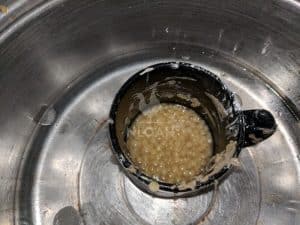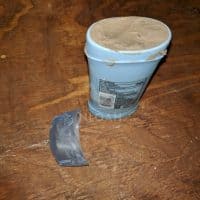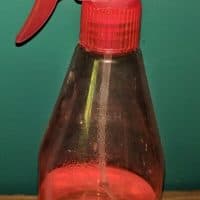Natural deodorant recipes have a lot in common with commercially manufactured deodorants and antiperspirants, but it is what they don’t have that is most important. The vast majority of store-bought deodorants contain aluminum and other potentially harmful toxins.
DIY natural deodorants are our best only option to control sweat and body odor without infusing your body with chemicals that could make you sick over time. Labels, even those on supposedly “natural” commercially manufactured deodorants, are often vague – at best.
Deodorants, cosmetics, perfumes, and many household cleaners are loosely regulated by the FDA. Companies are protected by proprietary work product and copyright rules which allow them to opt against disclosing all of the ingredients which go into products.
There are about 10,000 chemical ingredients in common cleaning, personal care, and beauty items that we can be exposed to on any given day.
The use of chemical laden deodorants or antiperspirants decreases the body’s ability to secrete toxins naturally. The barrie rubbed, rolled, or sprayed under the armpits clogs follicles in the skin – preventing people from sweating to the degree the body requires to cool down and cleanse itself.
7 Chemicals Found In Popular Deodorants
#1. Aluminum
This chemical ingredient is almost always at the top of the list in any article highlighting the potential dangers of using store bought deodorants. Exposure to aluminum could cause fluctuations in the estrogen levels, and might be linked to the contraction of Alzheimer’s disease, and interferes with your estrogen levels.
#2. Triclosan
Even though triclosan has been deemed a pesticide by the Food and Drug Administration (FDA) it is still a frequently used ingredient in top brand antiperspirants and deodorants. Triclosan is included as a typical recipe ingredient because it kills bacteria, but when it makes contact with the skin and water, it creates chloroform – a carcinogenic gas.
#3. Diethanolamine and Triethanolamine
Diethanolamine (DEA) and Triethanolamine (TEA) are chemicals that can affect negatively affect both the kidneys and liver after it seeps into your skin. Both DEA and TEA have been banned from use in Europe because they are deemed carcinogen level chemicals.
#4. Parabens
Parabens are chemical preservatives. It is possible that they behave as estrogen in our bodies, effectively disrupting hormonal balances. Parabens might be linked to both prostate and breast cancer.
#5. Propylene Glycol
When used on a daily basis, propylene glycol could cause liver, nervous system, and heart disease. Even when propylene glycol is used as only a single digit percentage of overall ingredients in deodorants, it may still produce damaging results over time. Some commercially manufactured deodorants contain as much as 50% of this synthetic ingredient.
#6. Steareths
These chemical ingredients are synthetic additives that produce both dioxanes and carcinogens during the processing of the deodorant mixture.
#7. Artificial Colors
We see this type of label on many products we use on our bodies and in our homes. While the phrase “artificial colors” may not sound ominous, some cause allergic reactions, and others have been deemed carcinogens.
Why are such potentially harmful ingredients allowed to be placed in products sold on American store shelves or labels be worded so vaguely? I have no answer to that question. But, I do know I am looking a lot more deeply into information printed on labels and packaging inserts these days.
I Don’t Want To Buy Deodorant Anymore, Now What?
You do not have to make a choice between smelling stinky, sweaty, dirty all the time or slathering possible carcinogens onto you body. Making all-natural deodorant is not a time-consuming, difficult, or expensive task.
DIY deodorant recipes have been floating around the internet for many years now. Unfortunately, some of them simply do not work well, others are too runny, some are too chunky, and others are just too abrasive to the skin.
You probably have most, or perhaps all, of the necessary ingredients in a cabinet on your homestead right now. You could simply mix together equal parts of coconut oil and baking soda to use in order to prevent body odor, but better options do exist.
Through multiple trial and error DIY all natural deodorant recipe mixing batches, along with some online research, I have found a few low-tox deodorant recipes that work well for myself and my family – even when working outdoors during the summer months.
Even though all of the ingredients in the recipes below are all natural, that does not mean all possibility allergic reaction is erased. It is best to do a small test patch first when trying one of the natural deodorant recipes for the first time – especially if you do not regularly use baking soda in homemade personal care items.
All Natural Baking Soda Base Ingredients
Coconut Oil – This carrier oil helps the natural homemade deodorant glide easily onto the skin. It also has healing and disinfectant properties – which come in handy if you have little cuts of shaving rash.
Baking Soda – The fine white powder absorbs both body odor and moisture naturally – without clogging the pores. It also neutralizes your pH balance, which is helpful to preventing odor.
Shea Butter – The butter made from African nut trees protects the skin from drying out and moisturizes it in the process – another plus if you suffer from dry skin, or if you have razor burn.
Bentonite Clay – This natural deodorant ingredient helps to reduce body odor and eliminate moisture without clogging the pores or causing a skin rash.
Beeswax – The wax solidifies the deodorant recipes, and keep them from melting or running when exposed to hot temperatures. Beeswax is also a natural moisturizer.
Cornstarch or Arrowroot Powder – These two powdery ingredients are interchangeable. Each helps wick away moisture from the skin without causing dryness. Arrowroot powder is sometimes difficult to find in rural areas.
DIY Natural Deodorant Storage
There are several inexpensive options to store your homemade deodorant. You can simply keep a container from your final store bought deodorant, wash it out thoroughly, and reuse it.
New plastic five ounce deodorant storage containers can be purchased online; they are often referred to as “blanks”.
The all natural deodorant can also be stored in a glass or plastic bowl, or in a small Mason jar, and just scooped out with fingers to use.
All Natural Deodorant Recipe
Ingredients
- 3 drops tea tree essential oil
- 2 tablespoons coconut oil
- 1 tablespoon beeswax pastilles recommended
- 1 1/2 tablespoons bentonite clay
- 3 drops lemongrass essential oil
- 2 tablespoon arrowroot powder or cornstarch
- 1 tablespoon baking soda
- 1 tablespoon shea butter
Instructions
- Bring the shea butter, coconut oil, and beeswax to a boil over medium heat using either a double boiler, chocolate melting machine, or by putting the ingredients in a coffee cup placed in a pot with a couple inches of water. In a double boiler, add coconut oil, shea butter and beeswax. Stir constantly to avoid scorching of the ingredients. Make sure the oil, butter, and wax are liquified before removing from the heat source.[mv_img id="34072"]

- After removing the mixture from the stove, quickly stir in the bentonite clay, cornstarch or arrowroot powder, baking soda, and essential oils. Make sure to stir thoroughly to completely combine all of the ingredients.
- Allow the deodorant to cool for about three hours so it solidifies. You can put the containers in the refrigerator to speed up the process.
Notes
Deodorant Ingredient Alternatives, Additions, and Substitutions
- You can add a total of 8 drops of essential oil to the recipe without causing it to become too runny to solidify. If you opt to add up to 10 drops, add a pinch more of both beeswax and cornstarch or arrowroot powder to firm up the mixture..
- When making natural deodorant during the spring through late summer months, or when recreating and working outdoors, I recommend adding citronella essential oil to the recipe to deter mosquitoes and other biting or stinging insects.
- 1 tablespoon of Diatomaceous earth can be added to the mixture to make it more a more potent body odor fighter, and to create a more durable solid stick of deodorant. It can also be substituted for cornstarch or arrowroot powder.
- To create a deodorant with a more subtle or manly scent, try adding in a few drops of any of the following essential oils: sandalwood, clove, cedarwood, cinnamon, juniper berry, and patchouli.
- Add up to 1 tablespoon of witch hazel to the mix as a preemptive dry skin soothing agent.
DIY Natural Solid Deodorant Recipe Hints and Tips
- Some folks could experience a skin rash or slight discoloration of the skin inside the armpit from using baking soda. If mild conditions like the occur, try reducing the amount of the baking soda in the recipe by half – while slightly increasing the cornstarch, arrowroot powder, or diatomaceous earth. If the symptoms continue, perhaps it is an essential oil that is causing the problem, one that you might be able to pinpoint by testing just the oil on a different patch of skin.
- 1 tablespoon of apple cider vinegar or 1 tablespoon of lemon juice could be used instead of baking soda in the natural deodorant recipe if the reaction to using baking soda is severe or ongoing, after ruling out an essential oil as the problematic ingredient.
- If you are allergic to coconut, omit the coconut oil and use extra shea butter to fulfill the measurement of the oil.
- You can also use almond, jojoba, olive, or avocado oil instead of coconut oil in this natural deodorant recipe. If using one of the substitute oils noted above, only use half as much as the recipe called for in coconut oil.
- If the natural deodorant recipe is leaving residue or a stain on your clothing, wait about five minutes to allow it more time to dry before putting on your clothes. I’ve never had a problem with any type of residue or staining, but some essential oils, especially when larger amounts are used, could cause this problem.
- I recommend waiting several minutes after shaving and dabbing the underarm area water and allowing it to air dry before putting on the deodorant. It is the baking soda in the natural deodorant recipe that typically causes some stinging when applied right after shaving.
All Natural Spray Deodorant Recipe
Ingredients
- 1/4 of a cup of 80 proof vodka (or any ethanol alcohol you have on hand – gin works well too. If you require more potent perspiration and body odor protection increase the proof of alcohol being used. Rubbing alcohol works fine, as well.
- 2 tablespoons of distilled white vinegar.
- Up to 8 drops of your favorite essential oils.
Instructions
- Simply pour all of the ingredients into a spray bottle and shake vigorously to combine. This recipe should remain potent and protective for at least three weeks before the level of protection decreases.
It may take your body several days to one week to adjust to either the solid or spray deodorant after spending so many years being treated with synthetic and chemical ingredients.
Typically, by day three, the feel and level of protection offered by either version of the DIY all natural deodorant, is in sync with your level of perspiration and skin.


Tara lives on a 56 acres farm in the Appalachian Mountains, where she faces homesteading and farming challenges every single day, raising chickens, goats, horses, and tons of vegetables. She’s an expert in all sorts of homesteading skills such as hide tanning, doll making, tree tapping, and many more.


